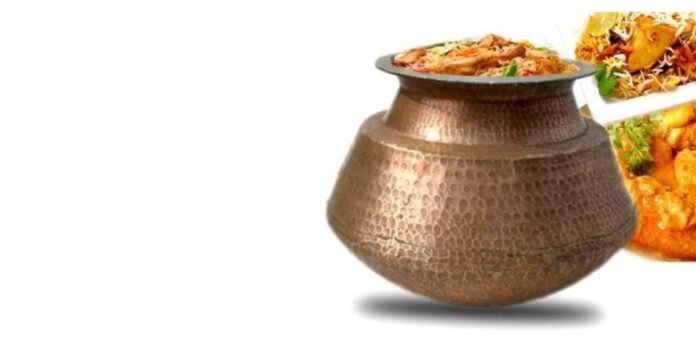In the courtyard of Lahore’s Data Darbar, a copper cauldron bubbles with lentils, thick with turmeric and garlic. Beside it, barefoot volunteers ladle steaming daal onto metal trays, and distributing food to the needy. Further south, in Karachi’s Saddar district, under a concrete overpass, men and women squat cross-legged before a cloth spread on the ground—the dastarkhwan—awaiting a simple meal of rice and curry. And in the quiet halls of Gurdwara Janam Asthan in Nankana Sahib, the aroma of slow-cooked sabzi and hand-rolled rotis fills the air, while Sikh volunteers chant kirtan and stir enormous vats with long wooden paddles.
These meals—offered without price, condition, or judgment—tell a story older than the nation itself. In Pakistan, the convergence of food and faith is not merely tradition—it’s theology made edible. Whether offered at a Sufi shrine, a Sikh gurdwara, or an urban community kitchen, these sacred meals form a quiet resistance against hunger, hierarchy, and invisibility. This is a culinary tour not just of dishes, but of philosophies—of what it means to feed and be fed in a country straddling ancient devotion and modern inequity.
Langar – Sufism’s Table of Radical Equality
At the heart of Sufi Islam lies the idea that the divine dwells in service. And nowhere is that service more tangible than at the langars—free communal kitchens—run at shrines across the country. These kitchens, inspired by early Chishti Sufis like Nizamuddin Auliya and Baba Farid, extend a sacred welcome to all, regardless of faith, caste, or class.
On any given day at Sehwan Sharif, the shrine of Lal Shahbaz Qalandar, one might see rickshaw drivers, pilgrims, widows, and children seated together, eating roti with sabzi or sweetened halwa from shared plates. The food is simple—no-frills but deeply nourishing: lentils slow-simmered with cumin, or fragrant pulao cooked in bulk over open fire.

As Annemarie Schimmel explains in her pivotal work Mystical Dimensions of Islam, food in the Sufi context is never merely nutritional—it is infused with barakah (blessing) and becomes a vehicle for spiritual transformation.
The scale is staggering. At Lahore’s Data Darbar, the daily langar feeds over 50,000 people. This is not charity; it is a sacred obligation. The Hadith records the Prophet Muhammad (PBUH) saying, “He is not a believer whose stomach is filled while his neighbor is hungry.” For Sufis, this principle became tradition. Everyone eats the same food, sitting shoulder to shoulder on the floor—a radical act in a society still shaped by feudal hierarchies.
Yet the tradition is not immune to critique. Some shrines have commercialized the langar, turning it into a spectacle for spiritual tourism or political visibility. Others rely on dwindling networks of elderly volunteers.
Gurdwara Kitchens – Seva Meets the Stove
Long before borders divided Punjab, the practice of langar—the free kitchen—was a cornerstone of Sikh spirituality. Instituted by Guru Nanak and systematized by Guru Amar Das, the gurdwara kitchen was designed to dismantle casteism and promote social cohesion. “Vand chhako” (share what you earn) remains one of the core tenets of Sikh faith.

In Pakistan, Sikh gurdwaras are fewer, but their kitchens are no less significant. At Nankana Sahib, the birthplace of Guru Nanak, and at Panja Sahib in Hasan Abdal, the ritual of langar continues even with a small Sikh population. The food is vegetarian by doctrine, ensuring it’s accessible to people of all faiths: thick kadhi with gram flour dumplings, seasonal vegetables sautéed in mustard oil, fluffy rotis, and the occasional kheer for dessert. Everything is prepared by sevadars (volunteers) with hands, hearts, and humility.
As Eleanor Nesbitt outlines in Sikhism- A Very Short Introduction, the langar is more than a meal—it is a form of equality. Its vegetarianism is not a dietary restriction, but a theological statement: all are welcome, none excluded. This ritual, enacted daily, is designed to collapse social boundaries, not reinforce them.
During Sikh festivals like Baisakhi or Guru Nanak’s Gurpurab, Muslim nei–ghbors are often invited, and partake freely. These shared meals, humble as they are, become moments of soft diplomacy. In an environment where religious identities can often polarize, a simple plate of sabzi and roti asserts that coexistence is possible—deliciously so.
The Urban Dastarkhwan: Feeding the Margins, Fighting Invisibility
Unlike the spiritual lineage of shrine langars or gurdwara kitchens, the modern Pakistani dastarkhwan is a response to urban precarity. Borrowing its name from Persian royal courts, today’s dastarkhwans are makeshift, mobile, and deeply necessary.
Set up by organizations like Saylani Welfare Trust, JDC Foundation, and the government’s Ehsaas Langar Program, these community meals have become vital lifelines.
The menus are pragmatic, optimized for scale and nutrition: daal chawal, biryani on Fridays, or sabzi with roti. Hygiene is prioritized—meals are served in disposable containers. During Ramadan or national crises, the volume of meals served multiplies. In 2022, according to reports by Saylani Welfare Trust, more than 125,000 meals were distributed daily in Karachi alone, with numbers doubling during peak months.
The beneficiaries form the invisible backbone of Pakistan’s cities: daily wage earners, orphaned children, street dwellers, flood-displaced families.

As Amartya Sen argues in Poverty and Famines, the problem of hunger is not just about food scarcity but about entitlement failure. People go hungry not because there is no food, but because there is no access. The modern dastar khwan is both a response to and an indictment of that failure. It fills a gap that policy has left open.
In many countries, innovations have been bought to repurpose excess restaurant food. Community kitchens now explore digital platforms to coordinate volunteers with restaurants. However, much needs to be explored and re-modelled.

At the Crossroads: Where Faith, Food, and Power Meet
These sacred food traditions—Sufi langars, Sikh gurdwara kitchens, and urban dastar khwans each rooted in distinct histories, ultimately converge on a shared moral ground: food as a means of restoring dignity, not reinforcing dependence. While their menus vary meat and halwa at shrines, vegetarian offerings in gurdwaras, or humble staples in street kitchens—the essence remains the same. These meals are served with anonymity, received without judgment, and eaten seated on the ground—a quiet, daily ritual that reaffirms humanity. In a fractured society, their true power lies not just in feeding bodies, but in honoring lives, equally and unconditionally.
dew.saba@gmail.com





